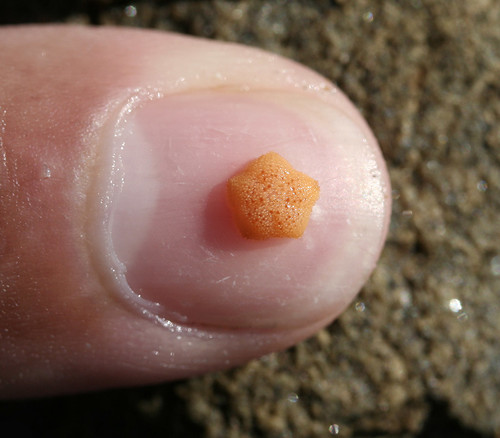Sunday, June 29, 2008
Sunday Science Finds
The Voodoo Wasp @PopSci.com
(Also see A Fluke of Nature @ Damn Interesting.)
Photosynthetic Marine Microorganisms do it for less oxygen:
Startling Discovery About Photosynthesis: Many Marine Microorganism Skip Carbon Dioxide And Oxygen Step @Science Daily
Cute & clever taxonomy:
Curiosities of Biological Nomenclature
From the main page:
"Scientific names of organisms are not usually known for their entertainment value. They are indispensable for clarity in communication, but most people skip over them with barely a glance. Here I collect those names that are worth a second look.
Some names are interesting for what they are named after (for example, Arthurdactylus conandoylensis, Godzillius), some are puns (La cucaracha, Phthiria relativitae), and some show other kinds of wordplay (such as the palindromic Orizabus subaziro). Some have achieved notability through accident of history, and many show the sense of humor of taxonomists."
Thursday, June 26, 2008
Dynamic Architecture

While we're on this whole skyscraper kick, how about a wind-powered tower? David Fisher, a French architect, is in the approval stage for two towers—one in Moscow and one in Dubai—where each floor rotates independently of one another, driven by wind turbines fitted in between each floor (which also creates the electricity to power the building, and possibly other nearby buildings as well). And Fisher's buildings will be less expensive to build because the core is all that's built on-site. The rotating pieces will be built elsewhere in a modular fashion, attached to the core and sent up. They'll be built from the top down!
Fisher's company, the Rotating Tower Technology Company, has these two projects on display at its website, and the videos are really quite stunning.
Via The Guardian by way of io9.
Wednesday, June 25, 2008
Taipei 101 on flickr

by Fishtail@Taipei
See more of flickr's most interesting images of th Taipei 101 building here. Many are very striking. For New Years the whole building produces fireworks.
Taipei 101 Damper movement on 12 May 08
Video caption:
Happened to be visiting Taipei 101 when the tremors from the earthquake in Sichuan was felt in Taipei..The damper is 660 ton in weight suspended on the 92 floor to 87 floor..
Also:
YouTube video of the Long Now technology display at Maker Faire 2008
Massively Gigantic Pendulum

So the Long Now Foundation, a group established to think about culture in the framework of 10,000 years as opposed to our current norm of thinking about this year, this moment, fast/faster/fastest, has been working on what they call the 10,000 Year Clock. It will be an entirely mechanical device that will tick once every year and last as long as the name says. From what I've seen so far, it's a beautiful piece of machinery, and it's been quite a bit of work for these guys.
In a new post on their blog today, they mention something they found while researching pendulums for their clock. In one of the tallest skyscrapers in the world, the Taipei 101 building, right up near the top, is a 728 ton tuned mass damper to help prevent the building from swaying during harsh conditions such as storms and quakes. The thing sways, and it offsets the sway of an entire skyscraper!

Look at that thing! It's humongous!
Also, while I'm writing about the Long Now Foundation, I should also mention that they have regular seminars which have become available as a podcast that I highly recommend. If that link doesn't work, you should be able to search the iTunes store for Long Now or SALT.
Tuesday, June 24, 2008
Tiny endemic, on flickr

Image by Nuysia@Tas.
Endemic species are found in one area, and no where else in the world. As such, they are extremely sensitive to habitat degredation and easily threatened.
From the caption:
The Tasmanian viviparous seastar, Patiriella vivipara. Adults achieve a full size of 13mm across. This tiny species is endemic to Tasmania, is known from a handful of locations and is considered threatened. Rather than going through the usual planktonic larval stage that most seastars go through, this species hold the larvae in it's gonad until they are fully formed. These minute baby seastars emerge from the backof the parent. This reproduction method limits the spread of this species to suitable habitat elsewhere along the coast.
View distribution map.
Patriella vivipara at Parks & Wildlife Service Tasmania web site.
Open Letter to Ministers re: Bill C-61 from LibriVox founder
I am the founder of LibriVox, an all-volunteer, web-based project to make audio recordings of public domain texts and give them away for free. Since our inception in 2005, we’ve run on a yearly budget of $0; yet we’ve become one of the most prolific makers of audio books in the world, with a production rate recently topping 100 books per month. We’ve got a catalog of some 1,500 audio books, including authors such as Dickens, Cervantes, Austen, Dante, Darwin, Sun Tzu, Hobbes, Einstein, and Plato. We also have a number of Canadian classics from Leacock, Lucy Maude Montgomery, and others. We have thousands of volunteers around the world, who make audio versions of texts and give them away because they believe access to knowledge and great literature is one of the most precious gifts we can give to each other. We’ve gained some fame over the years, with articles in the NY Times, radio spots on the BBC, as well as many more mainstream and web media mentions and profiles. The Vice President of Creative Commons recently called us “perhaps the most interesting collaborative culture project this side of Wikipedia.”
LibriVox is the sort of project that is on the outer edge of copyright case law, because what we do was not possible even a few years ago. At our core, we are about reading old books, but we use digital recording software, distributed production models, mass online collaboration, bit torrents, blogging and podcasting, online forums and wikis, bandwidth, mp3s and zip files, all to make recordings of old texts and give them away online for free.
I have some personal objections to Bill C-61 as it has been tabled, objections you’ve heard no doubt from thousands of concerned and angry Canadian citizens. But I wanted to outline two concrete examples of how Bill C-61 would criminalize legitimate activities of Canadian LibriVox volunteers.
Read whole letter here.
* I tried to contribute to LibriVox a year or two ago, but found that I'm no good at reading at a slow, good-for-listening pace. I also have several audio books from their site on my iPod including The Origin of Species and the autobiography of Olaudah Equino.
Monday, June 23, 2008
Charlie Angus on Bill C-61, Canadian DMCA
"But C-61 is about greed, not just rewards, about stifling the age-old enjoyment of sharing music with friends. It imposes a rigid black-and-white legal framework on a multihued, free-flowing landscape. It's about insisting on horse-and-buggy etiquette in an automotive age." - From The beat will go on despite the federal Conservatives @ The Vancouver Sun
Wednesday, June 18, 2008
The Big Picture
This isn't necessarily science-y, but this is probably my favorite new blog of all time.
The Big Picture is a daily photoblog full of very hi-res pictures focusing on a theme a day. It's a very young blog, and already there are too many good choices to link to here. But I'll try to exercise some restraint and link to the Cassini collection and the Chaiten Volcano collection.
So amazing!
Thursday, June 12, 2008
Heads Up!
Also: Michael Geist Blog.
Any suggestions on who to write besides the usual MPs and PM?
Edit: I received a mass email from Ministers Prentice and Verner and have already sent a reply cc: everyone I could find without spending too much time since I have a big exam tomorrow. I suggested that these two debate Doctorow and Geist live and air it on YouTube.
Wouldn't it be phenomenal if they actually did . . .
Monday, June 2, 2008
Can Life Evolve in Simulated Worlds?


